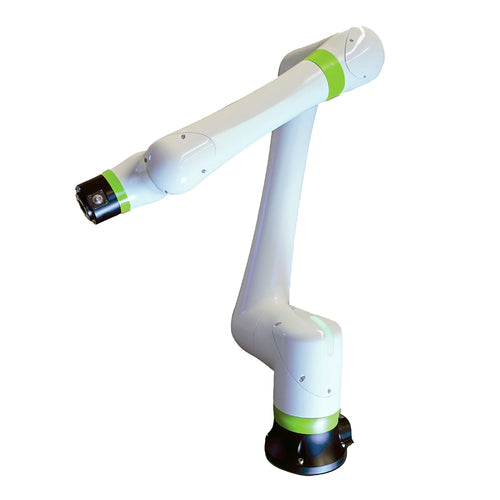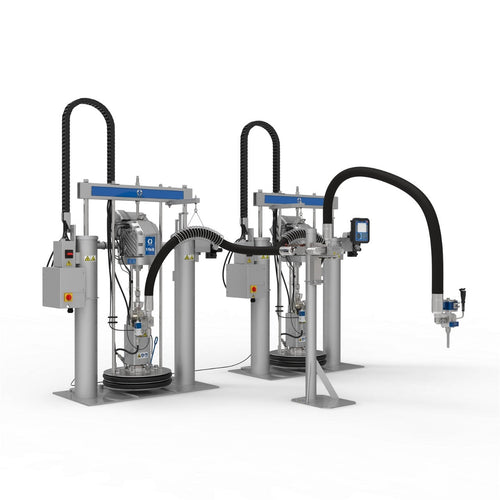Table of Contents:
- Manual Material Dispensing
- Semi-Automated Materials Dispensing
- Automated Material Dispensing
- How to Choose Your Level of Automation
- When to Use Manual Dispensing
- When to Use Semi-Automated Dispensing
- When to Use Automated Dispensing
Material dispensing is a common step in modern-day manufacturing and product assembly. Whether you are working with adhesives, sealants, greases, coatings, or something else, you need to ensure that the material you are using is dispensed accurately to get the finished product you need and effectively to match your work process.
As technology has advanced, so have the processes for materials dispensing. Manufacturers can choose between manual, semi-automated, and fully automated dispensing systems. The biggest difference between manual dispensing and automated dispensing systems is the level of human involvement. But which method of material dispensing should you pick? We compare manual versus semi-automated versus automated dispensing for adhesives and other materials, including their pros and cons, to help you determine which process is best for your specific needs.
Manual Material Dispensing
Manual dispensing of adhesives or other materials involves the use of handheld equipment and a human operator to dispense and apply the material. Compared to automated or semi-automatic adhesive dispensing, it is the most basic adhesive dispensing method and has been around for decades. Popular examples of manual adhesive dispensing equipment include cartridge guns, glue guns, syringes, and brushes.
Pros:
-
Easy to use and set up: Manual dispensing usually requires minimal training, and no programming is necessary.
-
Low initial cost: Compared to other methods of dispensing that can have a high initial price tag because of equipment costs, manual adhesive dispensing is generally less expensive.
-
Flexible use: Unlike other equipment that may need extensive reprogramming or reconfiguration, manual material dispensing can be easily adapted for use with different applications.
Cons:
-
A lot of room for error: Humans are imperfect beings, and human operation can lead to inconsistent and sometimes poor results.
-
Low throughput: Manual dispensing is slower and can limit throughput. It is not suitable for high-speed or high-volume production.
-
Operator fatigue: Manual adhesive dispensing can be more labor-intensive, and the repetitive tasks can lead to injury for the human operators.
-
Wasted material: Because manual dispensing of fluids, adhesives, and other materials can be so inconsistent, a lot of material can be wasted.
Shop our selection of dispensing cartridges and syringes.
Semi-Automated Adhesive Dispensing
Semi-automated dispensing systems use some degree of automation combined with manual operations. Human operators still play a role in manufacturing and perform some tasks, but they work with machines during production. Typically, the equipment will perform the most repetitive tasks, such as the actual dispensing. Humans will perform other related tasks, such as managing the equipment or loading and unloading components. Some examples of semi-automated dispensing equipment include meter mix dispensing systems or cobot dispensing systems.
Compared to manual adhesive dispensing, semi-automated adhesive dispensing tends to increase throughput and improve repeatability.
Pros:
-
Better consistency: Semi-automated adhesive dispensing systems decrease the room for human error and lead to consistent, repeatable results.
-
More efficient: These systems can increase production speed and drastically improve throughput.
-
Good ROI: While semi-automatic dispensing equipment can have a higher initial startup cost compared to manual dispensing tools, these systems generally have a great ROI and pay for themselves quickly.
-
Less floor space required: Compared to fully automated dispensing equipment that requires safety barriers or marked off floor space, semi-automated equipment for dispensing may fit neatly on a benchtop or take up limited floor space.
-
Improved operator safety: These machines often work alongside humans and can reduce physical strain from repetitive tasks as well as improve overall worker safety when dispensing involves dangerous materials.
-
Helps with labor shortage: Many businesses struggle to fill and keep skilled workers, but semi-automated material dispensing can help fill this gap.
Cons:
-
Some training required: Semi-automated dispensing machines require some amount of operator training and calibration.
-
Setup and integration needed: While many pieces of equipment are designed for easy integration into the production process, planning and setup time are still required.
-
Payload limitations: Compared to fully automated adhesive dispensing, semi-automation dispensing may have payload limitations.
Automated Dispensing
Automated dispensing systems use robotic equipment, vision guidance, and advanced software to completely control the dispensing process without much need for human involvement beyond the initial setup. Fully automated dispensing involves the use of industrial robots. These machines can apply precise and consistent volumes of material at high speeds.
Pros:
-
Consistent and accurate: Just like semi-automated dispensing, automated dispensing of materials leads to accurate and repeatable results without human error.
-
Maximum throughput: Fully automatic material dispensing is ideal when very high-speed, high-volume production is the primary focus.
Cons:
-
Highest initial cost: Compared to manual dispensing and semi-automated adhesive dispensing, fully automated adhesive dispensing comes with the highest price tag. The equipment itself and the cost of integration can be a significant capital investment that many businesses cannot afford.
-
Complex setup and programming: Planning, integration, and maintenance of fully automated systems for dispensing can be involved and time-consuming. It may also require skilled personnel or specialists.
-
Limited flexibility: Once the automation is set up, it is usually meant to stay as it is. Reprogramming or system changes can be costly and time-consuming compared to other dispensing methods.
-
Large space needs: Automated dispensing systems typically take up a significant amount of room. They also usually require safety fences or zones that can increase their floor space. For smaller operations, full automation may not be a realistic option.
How to Choose Your Level of Automation
Each adhesive dispensing method has its pros and cons, so you need to think about how it fits into your needs and what is most important to you. When comparing manual dispensing versus semi-automatic dispensing and automated adhesive dispensing, you should think about the following:
-
Production volume and scale
-
Warehouse space and current production setup
-
Precision/repeatability needed
-
Safety concerns
-
Initial costs and ROI
-
Future business goals
Together, all these factors can impact which method of adhesive dispensing is right for you.
Manual Adhesive Dispensing Is Best for:
-
Low-volume and low-speed operations
-
Environments where the dispensing application changes frequently
-
Businesses not looking to scale
For businesses only doing a limited amount of material dispensing or with a limited budget, manual dispensing may be the easiest method to choose. Scaling to some level of automation can always be done in the future.
Semi-Automated Dispensing Is Best for:
-
High-speed and high-volume production
-
Applications where consistency and precision are important
-
Businesses looking to increase their throughput and scale up from manual dispensing methods
-
Dispensing applications involving repetitive actions or dangerous materials
-
Businesses with limited floor space
-
Businesses struggling to find and keep skilled laborers
-
Business with limited or no experience with automation
Many consider semi-automated dispensing the sweet spot for automation. It can drastically increase throughput and efficiency without draining your budget or taking up all your floor space.
Browse our diverse collection of semi-automated dispensing equipment.
Fully Automatic Dispensing Is Best for:
-
Very high-volume and high-speed manufacturing
-
Applications involving high payloads
-
Businesses with a high budget and a lot of floor space
-
Businesses looking to maximize their production scale but not planning to change their application
Fully automated adhesive dispensing is not necessary for most businesses and is usually best for conglomerates with a large budget, workspace, and production quota.
Get Started
When it comes to material dispensing, there is no one-size-fits-all solution. Manual dispensing may be the best choice for some, while others may benefit from full automatic dispensing. For many, semi-automatic dispensing is the happy middle-ground, but everyone's needs are unique.
Whatever your current process, it may be time to reevaluate your needs and plan for the future. With a free technical consultation, our team can help you find the best dispensing solution for your specific needs. We can help with everything from equipment recommendations to automation equipment integration planning.










